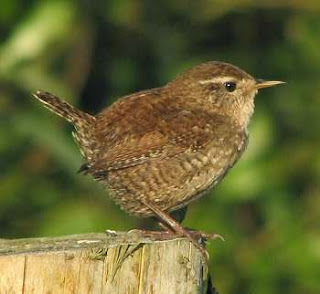Wren Watching
We noticed a wren in the beech hedge at our allotment recently. It was singing away and it felt as though spring had really arrived.
The wren is a tiny brown bird with a short upright tail. It's a common bird but I always like to see one, and it has a surprisingly loud voice for its size. Wrens eat caterpillars, spiders and all kinds of insects. The scientific name for the wren is Troglodytes troglodytes. Both sexes are known colloquially as Jenny Wren.
The wren's nest is a beautiful and intricate dome made of moss, leaves, grass, wool and feathers with a round entrance hole at the side. The nest is made by the male wren. In fact he makes several - all perfectly constructed. In the style of an estate-agent he will then escort the female wren on a tour of the nests until she decides which one she wants to make her nest in.
Two broods are normal and the male may take the first lot of young wrens to roost in one of the 'rejected' nests while the female incubates the second clutch. Although mostly monogamous, if there is a rich source of food in the area the male will set up more than one mate in his nests.
Keeping warm is a problem for wrens, and although they will huddle together in groups, they suffer heavy losses in hard winters.
A mid-winter tradition known as 'Wren Day' used to be carried out in the British Isles and parts of Europe. It originally included hunting and killing a wren as a sacrifice. Thankfully, later on a fake bird was substituted.
The wren is a tiny brown bird with a short upright tail. It's a common bird but I always like to see one, and it has a surprisingly loud voice for its size. Wrens eat caterpillars, spiders and all kinds of insects. The scientific name for the wren is Troglodytes troglodytes. Both sexes are known colloquially as Jenny Wren.
The wren's nest is a beautiful and intricate dome made of moss, leaves, grass, wool and feathers with a round entrance hole at the side. The nest is made by the male wren. In fact he makes several - all perfectly constructed. In the style of an estate-agent he will then escort the female wren on a tour of the nests until she decides which one she wants to make her nest in.
Two broods are normal and the male may take the first lot of young wrens to roost in one of the 'rejected' nests while the female incubates the second clutch. Although mostly monogamous, if there is a rich source of food in the area the male will set up more than one mate in his nests.
Keeping warm is a problem for wrens, and although they will huddle together in groups, they suffer heavy losses in hard winters.
A mid-winter tradition known as 'Wren Day' used to be carried out in the British Isles and parts of Europe. It originally included hunting and killing a wren as a sacrifice. Thankfully, later on a fake bird was substituted.
Submitted by Jane, plot 9

Comments
Post a Comment